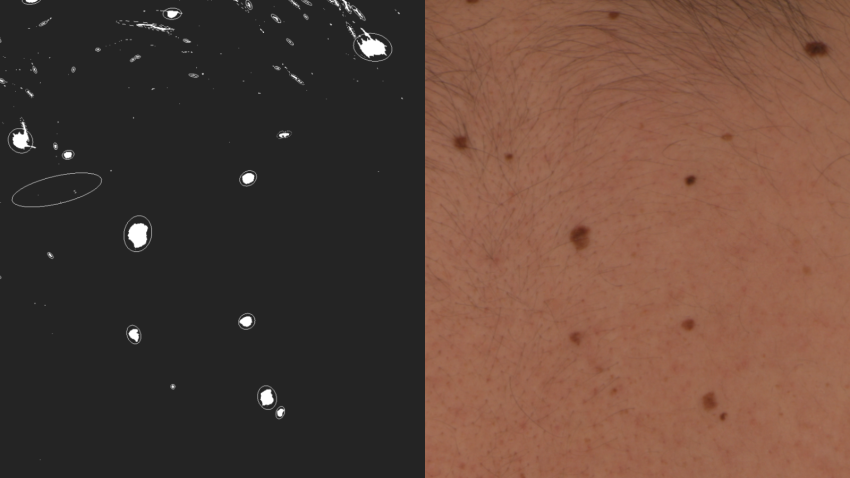Scientists are applying astronomical techniques to identify moles that may develop into the skin cancer melanoma. Astronomers regularly take images of the sky, producing software to map set targets over time. This technology is now being adapted to monitor the evolution of moles in high-risk patients. The work will be presented today (14 July) at the National Astronomy Meeting (NAM 2022) by Dr Meredith Morrell, a research fellow at the University of Southampton.
Cases of melanoma are rapidly growing in the UK, with early identification significantly increasing
survival rates. Skin cancer is one of the most common cancers in the UK; according to Cancer Research UK there are 16,000 new cases of melanoma and 147,000 of new cases of non-melanoma skin cancer diagnosed each year.
Often, high-risk patients have their full body photographed and inspected by dermatologists for any indication that existing moles have developed into melanoma. Currently, this process is incredibly time consuming as it requires highly qualified dermatologists to visually inspect every mole for any changes in appearance, and often relies on an element of self-diagnosis.
Astronomers routinely take pictures of the night sky, developing image processing software not only to identify and analyse targets in a single image, but also to map the evolution of those targets with multiple images taken over time.
The MoleGazer project aims to combine astronomical data analysis with full body photography used by dermatologists to monitor patients. Within the project, a patient’s skin is treated like the background sky in an astronomical image, and any moles are treated as stars. This analogy allows for automated identification and analysis of moles as they evolve over time.
The project is a collaboration between the University of Southampton and Oxford University Hospital. Full-body images from a set of high-risk patients have been used to develop a tool to assist dermatologists in diagnosing melanoma. MoleGazer has provided the evolutionary history of individual moles on a range of patients, that will now be used to moles that are at risk of developing into melanoma.
Future development is in progress to map the evolutionary pathways of benign moles into melanoma, and thus assist in the early diagnosis and treatment of skin cancer.
Morrell says: "The opportunity to apply techniques I'm already very familiar with to problems outside of astronomy is unique and exciting. Astronomers have been developing powerful tools for a long time. Finding ways we can use those tools elsewhere is important and a great example of collaboration between scientific disciplines."
Media contacts
Dr Robert Massey
Royal Astronomical Society
Tel: +44 (0)20 7292 3979
Mob: +44 (0)7802 877 699
nam-press@ras.ac.uk
Ms Gurjeet Kahlon
Royal Astronomical Society
Mob: +44 (0)7802 877700
nam-press@ras.ac.uk
Ms Cait Cullen
Royal Astronomical Society
nam-press@ras.ac.uk
Science contacts
Meredith Morrell
University of Southampton
M.V.Morrell@soton.ac.uk
Further information
Image: https://nam2022.org/images/Untitled_design_8.png
Caption: A side by side comparison of moles on a patient's back (right) and the same moles as star-like targets in the astronomical software used by the MoleGazer team (left).
Credit: The MoleGazer Team
Image: https://nam2022.org/images/StarField_1.png
Caption: A star field used for research by the MoleGazer Team.
Credit: The MoleGazer Team
Notes for editors
About NAM 2022
The NAM 2022 conference is principally sponsored by the Royal Astronomical Society (RAS), the Science and Technology Facilities Council (STFC) and the University of Warwick. Keep up with the latest conference news on Twitter.
About the Royal Astronomical Society
The Royal Astronomical Society (RAS), founded in 1820, encourages and promotes the study of astronomy, solar-system science, geophysics and closely related branches of science. The RAS organises scientific meetings, publishes international research and review journals, recognises outstanding achievements by the award of medals and prizes, maintains an extensive library, supports education through grants and outreach activities and represents UK astronomy nationally and internationally. Its more than 4,000 members (Fellows), a third based overseas, include scientific researchers in universities, observatories and laboratories as well as historians of astronomy and others.
Follow the RAS on Twitter, Facebook, Instagram and YouTube. Listen and subscribe to the Supermassive Podcast here.
About the Science and Technology Facilities Council
The Science and Technology Facilities Council (STFC) is part of UK Research and Innovation – the UK body which works in partnership with universities, research organisations, businesses, charities, and government to create the best possible environment for research and innovation to flourish. STFC funds and supports research in particle and nuclear physics, astronomy, gravitational research and astrophysics, and space science and also operates a network of five national laboratories, including the Rutherford Appleton Laboratory and the Daresbury Laboratory, as well as supporting UK research at a number of international research facilities including CERN, FERMILAB, the ESO telescopes in Chile and many more.
STFC's Astronomy and Space Science programme provides support for a wide range of facilities, research groups and individuals in order to investigate some of the highest priority questions in astrophysics, cosmology and solar system science. STFC's astronomy and space science programme is delivered through grant funding for research activities, and also through support of technical activities at STFC's UK Astronomy Technology Centre and RAL Space at the Rutherford Appleton Laboratory. STFC also supports UK astronomy through the international European Southern Observatory and the Square Kilometre Array Organisation.
Follow STFC on Twitter.
About the University of Warwick
The University of Warwick is one of the world’s leading research institutions, ranked in the UK’s top 10 and world top 80 universities. Since its foundation in 1965 Warwick has established a reputation of scientific excellence, through the Faculty of Science, Engineering and Medicine (which includes WMG and the Warwick Medical School).


